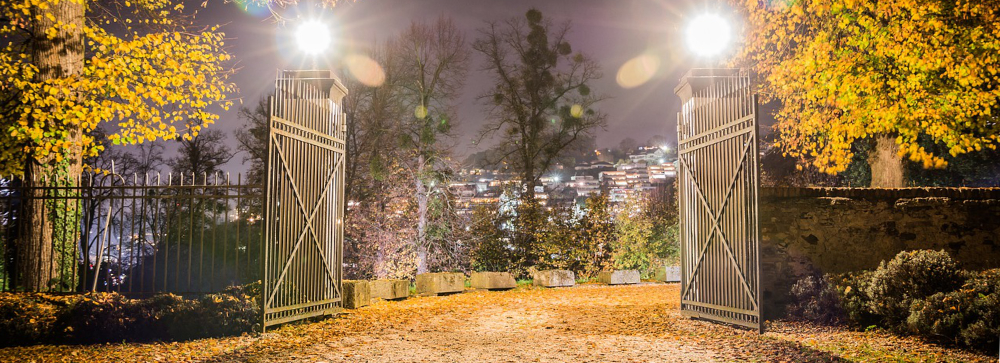Automated gates
Contents |
[edit] What are automated gates?
Automated gates, automatic gates or autogates (US term), are electrically powered gates that can be opened and closed from a distance. They are usually activated via a wired switch in the property or a remote control and often part of an automated entry and security system, with a fob or key code activated electric lock.
Today such electric gates (UK term) are common features of many buildings, from individual houses to hotels, retirement homes, as well as commercial, education and public buildings, acting as entry control systems to the grounds of these properties.
[edit] Component parts
The components of an automatic gate are likely to include a power supply, a gate motor and opening mechanism, a control board along with remote control or keypad and sensors, they should also include an emergency release system in case of emergency.
[edit] Classification, standardisation and certification
Automated gates are classified as machines under the EU Machinery Directive and in the UK, The Supply of Machinery (Safety) Regulations, brings the European Machinery Directive (currently 2006/42/EC) into UK criminal law. In the UK automated gates are also covered by the Loss Prevention Standards (LPS) which are overseen by the Loss Prevention Certification Board (LPCB) and cover the performance of security and fire safety products and services.
LPS 1175 Issue 8 standard was introduced to evaluate the resistance of physical security products such as windows, doors, fences, and gates, including automated gates. The standard also aims explain to, and assure, buyers, of, the different levels of strength in terms of resistance to manual forced entry, as is demonstrated, tested and evidenced.
Many of these types of products may also be voluntarily Secured By Design (SBD) certified. The Secured by Design membership scheme includes member companies whose products have been awarded the 'Police Preferred Specification' status. Products with the logo and title indicates that the company or product meet high standards set by Secured by Design, use is restricted exclusively to those that have successfully tested to Secured by Design requirements. Here is the current list Member Company Product Categories from Secured By Design.
Sold Secure is another certification system, Master Locksmiths Association and also recognised by Secured By Design, they offer a range of specifications, which includes SS323 Fences/Gates. Approval under this system is classified into 3 main categories; Bronze, Silver & Gold (with an addition of Diamond for certain product types). The categories reflect the amount of time allocated per test and the type of tools used, which can vary depending on what test is specified.
[edit] Example types of automated gates
There are many different types of standard gates, in terms of design, materials, uses as well as opening systems, most of these variations of standard manual gates can also be automated. Some examples are given below:
- Single parting sliding gates: have a single wheel-mounted gate that slides along a track to one side.
- Bi-parting sliding gates: have a two wheel-mounted gates that slide along a track to either side of the entrance.
- Single swing gates: have one leaf that can open in either direction, usually with an articulated arm.
- Double swing gates: have two leaves that can open in either direction, usually with an articulated arm.
- Hinged single gates: have one leaf that can open in one direction, usually with an articulated arm.
- Hinged double gates: have two leaves that can open in one direction, usually with an articulated arm.
- Bi-fold gates: have one or two leaves with a hinge in the centre to fold in half.
- Cantilever gates: Are similar to sliding, but the gate cantilevers across the opening.
- Telescopic sliding gates: Similar to sliding, but split in two or three layered leaves.
[edit] Related articles on Designing Buildings
- Access control.
- CCTV.
- Commercial security systems.
- Digital door lock market.
- ECA articles.
- Electric motor.
- Electrical energy.
- Electrical power.
- Electric lock.
- Entry control.
- Fence.
- Gate.
- Home security solutions market.
- How door locks work.
- Kissing gate.
- Modal filter.
- Outbuildings security.
- Perimeter security.
- Proximity access control system.
- Security and the built environment.
- Security glazing.
- Types of alarm.
- Types of barrier.
- Types of door.
- Types of lock.
- Visitor door entry system.
Featured articles and news
Gregor Harvie argues that AI is state-sanctioned theft of IP.
Preserving, waterproofing and decorating buildings.
Many resources for visitors aswell as new features for members.
Using technology to empower communities
The Community data platform; capturing the DNA of a place and fostering participation, for better design.
Heat pump and wind turbine sound calculations for PDRs
MCS publish updated sound calculation standards for permitted development installations.
Homes England creates largest housing-led site in the North
Successful, 34 hectare land acquisition with the residential allocation now completed.
Scottish apprenticeship training proposals
General support although better accountability and transparency is sought.
The history of building regulations
A story of belated action in response to crisis.
Moisture, fire safety and emerging trends in living walls
How wet is your wall?
Current policy explained and newly published consultation by the UK and Welsh Governments.
British architecture 1919–39. Book review.
Conservation of listed prefabs in Moseley.
Energy industry calls for urgent reform.
Heritage staff wellbeing at work survey.
A five minute introduction.
50th Golden anniversary ECA Edmundson apprentice award
Showcasing the very best electrotechnical and engineering services for half a century.
Welsh government consults on HRBs and reg changes
Seeking feedback on a new regulatory regime and a broad range of issues.

























